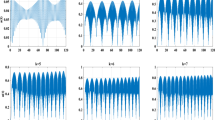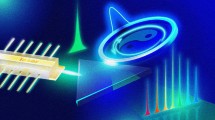Abstract
This paper describes the pulsing behaviour of Al x Ga1−x As double heterostructure (DH) lasers with and without an external dispersive resonator present. We have investigated only those lasers which show self-sustained oscillations under dc excitation. For the solitary diode we have found pulses possessing a width at half-power points, Δτ p, where Δτ p=0.9 ns and a repetition frequency,f os, ranging from 176 to 775 MHz depending on injection currentJ. Introducing a correlation time,t c, as a measure of the stability of the pulse height we have obtained 5 <t c < 40 ns. The maximum value oft c occurs in the vicinity of the crossing point off 2os andτ −2c , whereτ c is the effective carrier lifetime. Output pulsations are accompanied by spectral shifts of the longitudinal diode cavity modes. The frequency halfwidth, Δν Hw, ranging from 30 to 90 GHz is closely related to the maximum pulse power,P max. Coupling the laser diode to an external resonator, pulse widths, oscillation frequencies and correlation times have been determined as functions ofJ/J th (J th is the threshold injection current), provided the photon roundtrip time is nearly equal toτ c and the equivalent reflection factorR * of the external resonator isR * ∼ 0.87. By evaluating the experimental findings pulsing under dc excitation may be described, without a detailed knowledge of the reasons leading thereto, by using the concepts of a nonstationary quality factorQ ns and time-dependent resonator losses characterized by Δν Hw/δτ p. Oscillations become self-sustained forQ ns=const., i.e. the minimum photon density with which the pulses start to grow has to be time and excitation independent, in this casef 2os is proportional toJ/J th as well as Δτ p to (J/J th −1)−1/2.
For certain ranges of injection current a double hysteresis has been found. In the upper branch of this hysteresis the output is continuous wave, occurring in a single mode of the coupled system. All other parts of theP-J curve are characterized by output pulsations. The carrier trap model proposed by Copeland allows a qualitative description of the experiments including calculations of the electron capture cross-sectionσ 0 and the minimum pulse width Δτ p,min estimated asσ 0=3.6×10−16cm2 and Δτ p, min, ∼-0.9 ns. According to our measurements the dynamic loss originating in carrier consumption/ release due to traps is responsible for pulsing behaviour and double-switching along the hysteresis curve.
Similar content being viewed by others
References
H. Statz andG. De Mars, in ‘Quantum Electronics’, edited by C. H. Townes (Columbia University Press, New York, 1960) p. 530.
K. Shimoda,Proc. Opt. Masers (1963) 95.
J. P. Van Der Ziel, J. L. Merz andT. L. Paoli J. Appl. Phys. 50 (1979) 4620.
H. Weber, PhD Thesis, Tu, Berlin (1965).
P. Glas, internal report 1981, unpublished.
N. G. Basov,IEEE J. Quantum Electron. QE-4 (1968) 855.
V. V. Nikitin, A. S. Seminov andV. P. Strakov,J. Expt. Theoret. Phys. Lett. 9 (1969) 313.
M. J. Adams,Phys. Status. Solidi A1 (1970) 143.
Idem, Opto-Electronics 5 (1973) 207.
J. A. Copeland,Electron. Lett. 14 (1978) 809.
D. Kato,Appl. Phys. Lett. 31 (1977) 588.
T. L. Paoli andJ. E. Ripper,Phys. Rev. Lett. 21 (1969) 1085.
K. Kobayashi, H. Yonezu, F. Saito andY. Nannichi,Appl. Phys. Lett. 19 (1971) 323.
L. Figueroa,IEEE J. Quantum Electron. QE-17 (1981) 1074.
J. C. Dyment andK. D. Chik,J. Appl. Phys. 51 (1980) 5252.
P. Glas andR. Müller,Opt. Quantum Electron. 14 (1982) 375.
A. Olsson andC. L. Tang,Appl. Phys. Lett. 39 (1981) 24.
M. W. Fleming andA. Mooradian,IEEE J. Quantum Electron. QE-17 (1981) 44.
C. Harder, K. Y. Lau andA. Yariv,Appl. Phys. Lett. 39 (1981) 382.
Idem, ibid. 40 (1982) 369.
R. Lang andK. Kobayashi,IEEE J. Quantum Electron. QE-16 (1980) 347.
P. Glas, R. Müller andA. Klehr,Opt. Commun. 44 (1983) 196.
J. A. Copeland,J. Appl. Phys. 51 (1981) 1919.
H. S. Sommers andD. O. North,Solid State Electron. 19 (1976) 675.
D. D. Cook andF. R. Nash,J. Appl. Phys. 46 (1975) 1660.
P. Glas, P. Hartwig andG. Erbert,Opt. Quantum Electron. 16 (1984) 297.
R. Müller andP. Glas,Zh. Phys. B — Condensed matter 54 (1984) 271.
J. A. Copeland,IEEE. J. Quantum Electron. QE-16 (1980) 721.
B. W. Hakki,J. Appl. Phys. 50 (1979) 5630.
Author information
Authors and Affiliations
Rights and permissions
About this article
Cite this article
Glas, P., Klehr, A. & Hartwig, P. A comparative study of intensity pulsations in a double heterostructure AlxGa1−xAs laser with and without an external resonator present. Opt Quant Electron 17, 175–186 (1985). https://doi.org/10.1007/BF00620360
Received:
Revised:
Issue Date:
DOI: https://doi.org/10.1007/BF00620360




